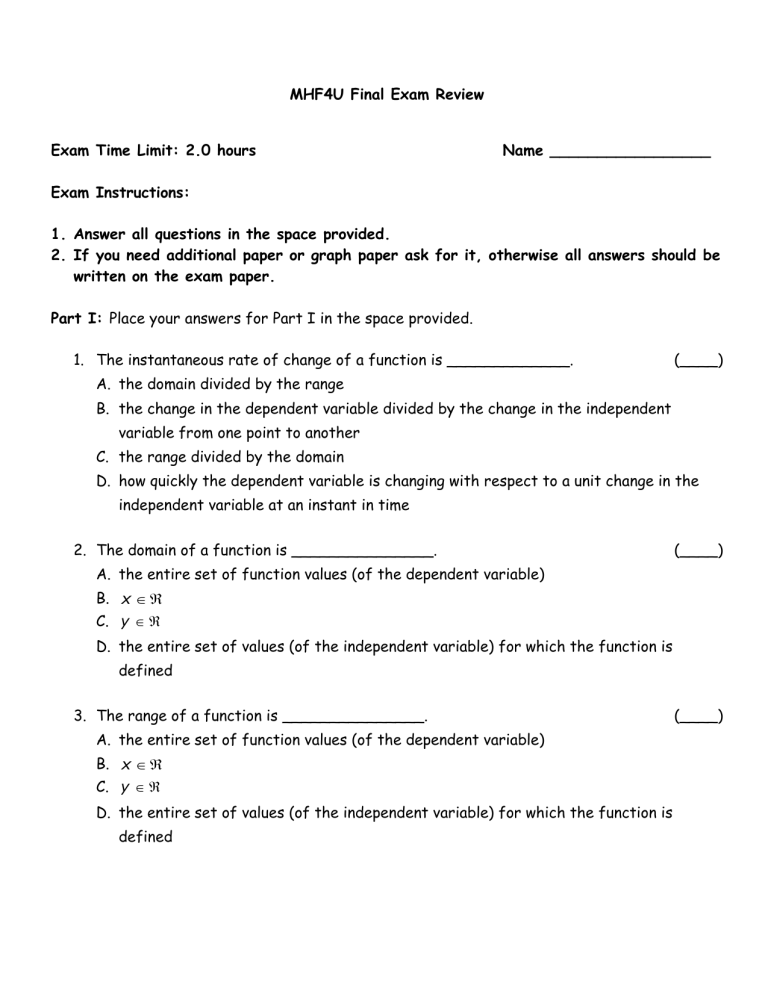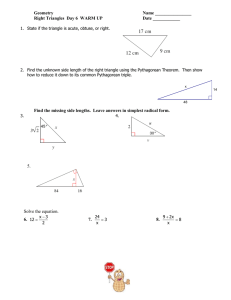
MHF4U Final Exam Review Exam Time Limit: 2.0 hours Name _________________ Exam Instructions: 1. Answer all questions in the space provided. 2. If you need additional paper or graph paper ask for it, otherwise all answers should be written on the exam paper. Part I: Place your answers for Part I in the space provided. 1. The instantaneous rate of change of a function is _____________. (____) A. the domain divided by the range B. the change in the dependent variable divided by the change in the independent variable from one point to another C. the range divided by the domain D. how quickly the dependent variable is changing with respect to a unit change in the independent variable at an instant in time 2. The domain of a function is _______________. (____) A. the entire set of function values (of the dependent variable) B. x C. y D. the entire set of values (of the independent variable) for which the function is defined 3. The range of a function is _______________. A. the entire set of function values (of the dependent variable) B. x C. y D. the entire set of values (of the independent variable) for which the function is defined (____) 4. Which one of the following is a polynomial function? (____) 2 A. n x 3cos 6 x 4 3 B. f x 3 3 x 6x 2 x 11 4 C. q x 3log2 4x D. f x 3 5x 4 5. The ____ row of differences for quartic functions are all the same. (____) A. 1st B. 2nd C. 3rd D. 4th 6. Even functions have which of the following characteristics? A. f x f x B. f x f x (____) 1 1 C. f x f x a a 7. The Remainder Theorem states ___________. A. When a polynomial P x is divided by x b the remainder is P b (____) B. If P b 0 , then x b is a factor of P x C. The remainder in the division P x b is P b D. If x b divides P x with a remainder of zero, then x b is a factor of P b 8. The Factor Theorem states ___________. A. When a polynomial P x is divided by x b the remainder is P b (____) B. If P b 0 , then x b is a factor of P x C. The remainder in the division P x b is P b D. If x b divides P x with a remainder of zero, then x b is a factor of P b 9. What is the domain of h x A. x x 2 B. y y 9 7 C. x x 2 D. x 9x 3 ? 7 x 14 (____) 10. What is the horizontal asymptote for f x A. y 5 B. x 10x ? 2x 3 (____) 3 2 C. y 10 D. y 2 11. What is the vertical asymptote for f x A. x 2 B. x 3 2 C. x 2 3 10x ? 2x 3 (____) D. y 2 12. In a right angled triangle sin opposite opposite A. B. hypotenuse adjacent 13. In a right angled triangle cos opposite opposite A. B. hypotenuse adjacent 14. In a right angled triangle csc opposite opposite A. B. hypotenuse adjacent 15. In a right angled triangle tan opposite opposite A. B. hypotenuse adjacent 16. In a right angled triangle sec opposite opposite A. B. hypotenuse adjacent 17. In a right angled triangle cot opposite opposite A. B. hypotenuse adjacent C. C. C. C. C. C. adjacent hypotenuse D. opposite hypotenuse adjacent hypotenuse D. opposite hypotenuse adjacent hypotenuse D. opposite hypotenuse hypotenuse hypotenuse D. opposite adjacent E. E. E. E. adjacent opposite adjacent opposite adjacent opposite adjacent opposite adjacent opposite hypotenuse hypotenuse D. opposite adjacent E. hypotenuse hypotenuse D. opposite adjacent adjacent E. opposite (____) (____) (____) (____) (____) (____) 7 6 1 A. 3 18. tan (____) B. 1 4 3 2 A. 3 C. 3 D. 1 E. 3 3 19. csc (____) B. 1 3 2 A. -1 C. 3 D. 2 2 3 E. 20. cot (____) B. 1 C. 3 D. 0 E. undefined 21. To convert degrees to radians, multiply by _________ 2 A. B. C. D. 180 180 360 22. csc 1 A. tan B. 23. sec 1 A. tan B. 24. cot 1 A. tan B. 1 cos 1 cos 1 cos C. C. C. 1 cot D. 1 cot D. 1 cot D. 5 25. Which of the following is equivalent to sin 6 3 7 5 A. sin B. tan C. sin 4 2 6 26. Using the diagram at the right, sec A. 146 5 B. 146 11 C. 11 5 D. 5 11 1 sin 180 E. 1 csc E. 1 sin 1 csc E. 1 sin 1 csc E. ? (____) (____) (____) (____) D. cos 15 4 5 E. (____) 11 146 4 E. cos 3 β 11 1 (____) 27. sin x 2 A. sin x 2 (____) B. cosx C. sinx D. cosx E. csc x 2 28. tan x 2 (____) B. cosx A. cotx C. cotx E. csc x 2 D. cosx 29. Determine the equation of the function pictured at the right? 1 A. y 4 cos x 2 (____) B. y 4 sin2x 1 D. y 4 sin x 2 C. y 4 cos2x 1 E. y 3cos x 2 30. Determine the equation of the function pictured at the right? A. y 5cos2 x 1 B. y 5 sin2 x 1 6 6 1 1 C. y 5cos x 1 D. y 4 sin x 2 2 6 (____) E. y 5cos 4x 1 31. sinx A. sinx B. cos x 2 C. cosx D. cos x 2 E. sec x 2 (____) 32. The graph at the right is ______. A. y cot x (____) B. y csc x C. y tan x D. y sin x E. y sec x 2 33. What is the amplitude of y 3cos2 x 5? 3 2 right A. B. 3 C. 5 down D. 2 3 (____) E. -2 34. What is the amplitude of y sin x 6 ? 4 A. left 4 B. 2 C. 6 up D. 1 35. What is the period of y 4 sin5 x 2 ? 4 2 A. 4 B. C. D. 2 down right 5 4 36. The graph shown is ________. A. y 2x B. y 3x C. y 4x 1 D. y 4 x x 1 E. y 3 (____) E. -1 (____) E. 5 (____) 37. The graph shown is ________. (____) A. y 2 x B. y 3x x 1 C. y 2 x 1 D. y 3 1 E. y 4 x p 38. Write h 3 in its equivalent logarithmic form. A. p log3 h B. h log3 p C. 3 log p h (____) D. log3 p h 39. Write loga b c in its equivalent exponential form. A. b c a 40. Simplify B. a c b D. c b a 1 log2 x 2 2log2 y 8 log2 z into one logarithm. 3 A. log2 3 x 2 z 8y 2 C. c a b (____) 3 x 2z 8 y2 B. log2 C. log2 F GGH x 2y 2 z8 (____) I JJK D. log2 F GH 2 x 3z 8 y2 I JK Part 2: Show all work you do in the space provided for each question in part 2. 1. Use the graph at the right for each of the following questions. a) Determine Albert’s average velocity from 2 to 6 seconds. b) Determine Albert’s instantaneous velocity at 4 seconds. 2. Use differences to determine the degree of the polynomial functions that the following tables represent. a) x y -2 -1 0 1 2 3 27 -1 -7 -3 -1 -13 b) x y -2 -1 0 1 2 3 43 0 -7 -2 15 68 3. Solve completely by factoring. a) 2x 3 5x 2 x 6 0 b) 3x 4 8x 3 4x 2 16x 4. Solve without using technology. a) x 2 4x 32 0 b) 2x 2 11x 6 0 y 5. Sketch the function f x 5 . Be sure to 2x 8 10 indicate all asymptotes and intercepts (if any). Show how to get each behavior near any 5 asymptotes. x -10 -5 5 -5 -10 10 6. Find the asymptotes for each of the following functions. a) f x 6x 3 4x 12 b) f x 7x 1 x x 2 2 7. Solve each of the following rational equations. 1 7 4 a) 3 5m m b) x 3 x 4 x 2 18 x 2 x 4 8. Use a numerical method to approximate the instantaneous rate of change for the 2x 7 function f x where x = 2.8. x 3 9. The radius of the earth is 6380 km. A space shuttle 300 km above the earth travels 11 around the planet through an angle of radians. How far does the shuttle move? 6 10. Use a compound angle identity to rewrite sin sin 3 trigonometric ratio and then find its exact value. 3 3 cos cos as one single 4 3 4 11. Determine the average rate of change for the function at the right from where x = 0.2 to x = 1.1. y 12. Solve on the interval 0 2 . a) 2sin2 7 sin 4 0 b) 2cos2 3cos 2 0 x 13. Prove each of the following. a) sin tan cos b) sin cos cot sec tan c) 2csc2x tan x sec x 2 14. The sunset time varies sinusoidally with time. The sunset time (S) in the town of Parry 2 Sound can be modelled by the equation S 1.75cos d 172 18.4 , where d is the 365 day of the year. How long a period of time (in days) is the sun setting earlier than 7:00 p.m.? You may use technology to solve this problem. If you do use technology, include a neat labelled sketch with your solution. 15. Evaluate log6 93 . Explain how you can check this answer. 16. Solve each of the following. a) 4x 50 b) 95x 221 17. Evaluate without the use of the log function on a calculator. (Hint: use the log laws) a) log9 3 log9 27 b) 3log5 25 18. Simplify each of the following using the three laws of logarithms. a) log3 144 log3 6 c) b) 4log7 2x log7 8xy 3 19. Solve each of the following. a) log9 (x 5) 1 log9 (x 3) 1 log z 5log x 2log u 3 3 b) log4 (x 2) log4 10 log4 (x 2 5x 14) c) 93x 1 27 x [Write the answer in exact form] d) 52x 4 5x 5 0 20. The magnitude, M, of an earthquake is measured using the Richter scale, which is defined I as M log . I is the intensity of the earthquake, and Io is the intensity of a standard Io low level earthquake. a) What is the Richter Scale reading for an earthquake that is 45000 times more powerful than the standard low level earthquake? b) How much more powerful is a 6.8 Richter Scale earthquake than a 4.0 scale quake? 21. A 60 mg sample of a radioactive isotope decays to 50 mg after 4.7 days. a) Determine the half-life. b) How long will it take for the amount of the isotope to decrease to 20 mg? a) Graph h x f x g x 22. Given f x 4x 2 2x 1 and g x 3x . y 10 5 b) Solve the inequality 4x 2 2x 1 3x x -10 -5 5 -5 -10 c) Find and simplify g f x and f g x d) Explain why you would expect g f x and f g x to be different. 10



